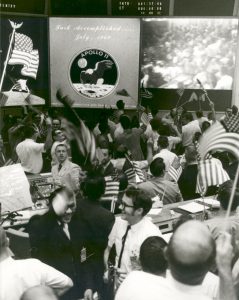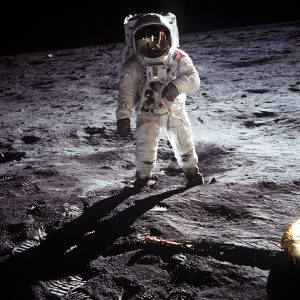July 16, 2019
The Semicentennial of Apollo 11: A 50 Year-long Leap for Mankind
Posted by Caitlin Bergstrom
Elena Symmes is a 2019 summer intern with the Public Affairs team at AGU and a graduate student at the University of Virginia interested in American and environmental history.

In the Mission Operations Control Room of the Mission Control Center, Building 30, Manned Spacecraft Center, flight controllers applaud the splashdown and success of the Apollo 11 lunar mission. Four days earlier on July 20, 1969, mission commander Neil Armstrong and lunar module pilot Buzz Aldrin landed on the moon. Image source: NASA.
On July 20th 1969, the nervous occupants of the Mission Control room responsible for orchestrating the Apollo 11 moon landing erupted into cheers. They had just received confirmation that the risky mission to send Astronauts Michael Collins, Buzz Aldrin, and Neil Armstrong to walk on the moon, was a sweeping success. America rejoiced while the rest of the world looked on, her celebrations a bullhorn announcing the end of the Space Race, cementing the United States’ dominance in spaceflight.
Following World War II, the United States’ enjoyed significant post-war affluence, symbolic of their new status as the single remaining world power. As the presumptive world leader, the United States was relatively unscathed in comparison to the other nations touched by the brutal warfare, and was able to fund science research in investments most nations could not afford.
Federal funding for science turned the near-impossible into achievable goals. The United States federal government aggressively prioritized lunar exploration beginning in 1961, inaugurated by President John F. Kennedy’s famous announcement in 1961: “Before this decade is out, of landing a man on the Moon and returning him safely to the Earth.”

Astronaut Buzz Aldrin walks on the surface of the moon near the leg of the lunar module Eagle during the Apollo 11 mission. Mission commander Neil Armstrong took this photograph with a 70mm lunar surface camera. Image source: NASA
The mission is a powerful example of the important role of federal dollars in supporting high-stakes science. NASA’s blue-ribbon leap across the lunar finish line was not only a much-needed national security victory during the Cold War, it has also remained relevant to current research and development policy. The astronomical costs of the Apollo program, worth approximately $153 million today, were bankrolled by the national government as a part of the federally-funded and popular effort to explore the cosmos in competition with the Soviet Union.
The Cold War and the Space Race were inextricably linked. A competition to rack up firsts in spaceflight capability, the Space Race was a federally-mandated national security initiative that used space exploration as a yardstick to measure the merits of free market democracy alongside the backdrop of rising tide of Communism abroad. It also redistributed the surplus of military-industrial resources left over from wartime rapid manufacturing.
The successful landing ushered in an unprecedented acceleration in research and development in federal agencies. For example, Federal laboratories studied lunar rock samples as well as the spacecraft itself to send science further afield down new paths of scientific inquiry. Public support and proactive federal participation in the Apollo 11 mission demonstrated how valuable the returns on scientific investment can be when appropriated properly, inspiring new research in important areas such as space weather, lunar water, and amino acids.
The Apollo 11 mission was the culmination of numerous federal programs, countless government dollars, immeasurable manpower, and thousands of hours. It was a symbol of the value Americans placed on the idea of progress and prioritization of innovation and exploration. A triumphant, glorious leap forward in scientific knowledge, it bettered the universal human condition across all geopolitical divisions.
Informed policy decisions help to advance the betterment of human society, as also encouraged by AGU (see our position statement on public support for science) and partner organizations. To remain at the forefront of global science R&D, the science community relies on federally-sponsored academic research. 21st century America should use the 50th anniversary of the moon landing as a reminder that it is possible to address the important issues facing the nation here on Earth while also exploring our solar neighborhood and beyond.

